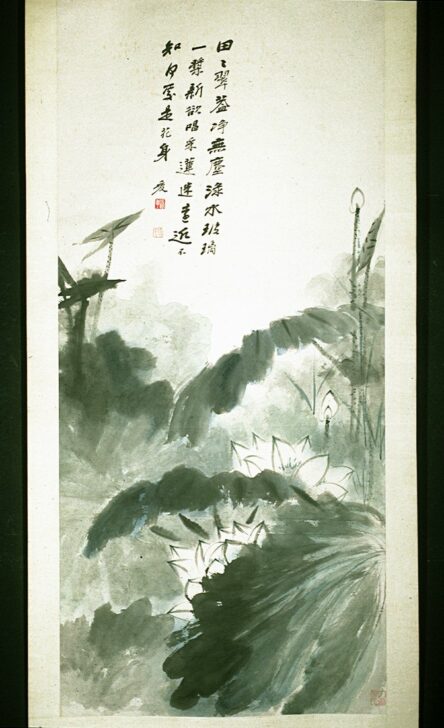Lotus Blossom
Zhang Daqian (Chang Ta-ch'ien)

Description
Zhang Daqian
China, ca. 1899–1983
Lotus Blossom
1965–75
Hanging scroll, ink and color on paper
Gift of Richard and Vee Ling Edwards In Memory of Li Ch’i, Scholar,
Poet, Friend, 1991/1.67
In China, the lotus has been a symbol of well-being since ancient
times. The pod, abundant with seeds, came to be associated with the
desire for many offspring. Because the lotus emerges as a pure white
blossom from the muck of a swamp, in Buddhism it is a symbol of
the intrinsic purity of the “Buddha-nature” within all living beings.
Confucian thought likens the lotus blossom to the pure and lofty
character of a gentleman who is above worldly concerns.
For Zhang Daqian, painting lotuses seems to have offered an ideal
opportunity for a tour-de-force formal exercise in blue, gray, and
black ink washes. He is considered one of the most versatile and
prolific artists of twentieth-century China.
Summer 2023 Gallery Rotation
__________
In China, the lotus has been a symbol of well-being since ancient times. The pod, abundant with seeds, came to be associated with the desire for many offspring. In Buddhism, the lotus is a symbol of the intrinsic purity of the “Buddha-nature” lying within all living beings, because it emerges as a pure white blossom from the muck of a swamp. A Confucian layer of meaning likens the lotus blossom to the pure and lofty character of a gentleman who is above worldly concerns.
For Zhang Daqian (also known as Zhang Yuan / Chang Yüan), the artist of this scroll, painting lotuses seems to have offered an ideal opportunity for a tour-de-force formal exercise in blue, gray and black ink washes. Zhang Daqian was one of the most famous, versatile, and prolific artists of twentieth-century China.
Maribeth Graybill, Senior Curator of Asian Art
Exhibited in "Flora and Fauna in Chinese Art," April 6, 2002 - December 1, 2002.
(Chinese Gallery Rotation, Spring 2009)
Subject Matter:
In China, the lotus has been a symbol of well-being since ancient times. The pod, abundant with seeds, came to be associated with the desire for many offspring. In Buddhism, the lotus is a symbol of the intrinsic purity of the “Buddha-nature” lying within all living beings, because it emerges as a pure white blossom from the muck of a swamp. A Confucian layer of meaning likens the lotus blossom to the pure and lofty character of a gentleman who is above worldly concerns.
Perhaps the lotus rising out of muddy waters are alluding to the elusive nature of wisdom or purity. Zhang Daqian was one of the most famous, versatile, and prolific artists of twentieth-century China.
Physical Description:
Blue, gray and black ink washes are used to depict lotus blossoms rising out of and partially hidden by plants and muddy waters. A poem is written above, alluding to the lotus blossoms below.
Usage Rights:
If you are interested in using an image for a publication, please visit https://umma.umich.edu/request-image/ for more information and to fill out the online Image Rights and Reproductions Request Form.